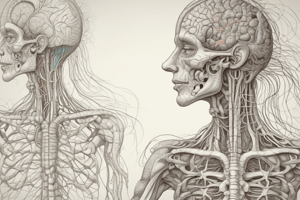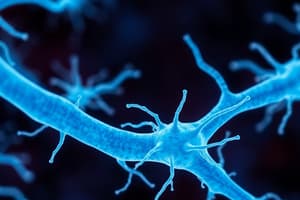Podcast
Questions and Answers
How do the sympathetic and parasympathetic nervous systems counteract each other to maintain homeostasis?
How do the sympathetic and parasympathetic nervous systems counteract each other to maintain homeostasis?
The sympathetic nervous system activates the 'fight or flight' response, increasing heart rate and alertness, while the parasympathetic system promotes 'rest and digest' functions, slowing heart rate and stimulating digestion. They balance each other to maintain a stable internal environment.
Explain how the structure of the alveoli in the lungs facilitates efficient gas exchange.
Explain how the structure of the alveoli in the lungs facilitates efficient gas exchange.
The alveoli are small, thin-walled air sacs with a large surface area and are surrounded by capillaries. This close proximity and large surface area allow for efficient diffusion of oxygen into the blood and carbon dioxide out of the blood.
Describe the roles of arteries, veins, and capillaries in transporting blood throughout the body.
Describe the roles of arteries, veins, and capillaries in transporting blood throughout the body.
Arteries carry oxygenated blood away from the heart to the body tissues, veins return deoxygenated blood back to the heart, and capillaries are tiny vessels where oxygen and nutrients are exchanged with tissues.
How do actin and myosin filaments interact to produce muscle contraction?
How do actin and myosin filaments interact to produce muscle contraction?
What are the roles of the liver, pancreas, and gallbladder in the digestive process?
What are the roles of the liver, pancreas, and gallbladder in the digestive process?
If a person experiences damage to their somatic nervous system, what type of functions would be impaired?
If a person experiences damage to their somatic nervous system, what type of functions would be impaired?
Explain the difference between external and internal respiration and where each process occurs.
Explain the difference between external and internal respiration and where each process occurs.
How does the cardiovascular system adjust to meet the increased oxygen demands of muscles during exercise?
How does the cardiovascular system adjust to meet the increased oxygen demands of muscles during exercise?
Differentiate between muscle hypertrophy and muscle atrophy, including the conditions that cause each.
Differentiate between muscle hypertrophy and muscle atrophy, including the conditions that cause each.
Describe the process of peristalsis and its importance in the digestive system.
Describe the process of peristalsis and its importance in the digestive system.
Flashcards
Nervous System
Nervous System
Coordinates bodily activities via brain, spinal cord, and nerves.
Central Nervous System (CNS)
Central Nervous System (CNS)
Brain and spinal cord form this control center.
Sensory Neurons
Sensory Neurons
Transmits signals from receptors to the CNS.
Somatic Nervous System
Somatic Nervous System
Signup and view all the flashcards
Sympathetic Nervous System
Sympathetic Nervous System
Signup and view all the flashcards
Respiratory System
Respiratory System
Signup and view all the flashcards
Diaphragm
Diaphragm
Signup and view all the flashcards
Cardiovascular System
Cardiovascular System
Signup and view all the flashcards
Arteries
Arteries
Signup and view all the flashcards
Muscular System
Muscular System
Signup and view all the flashcards
Study Notes
- Human anatomy is the study of the structure of the human body
- Human physiology is the study of the function of the human body
Nervous System
- The nervous system coordinates and controls bodily activities
- The nervous system consists of the brain, spinal cord, and nerves
- Neurons are the basic functional units of the nervous system, transmitting electrical and chemical signals
- The central nervous system (CNS) includes the brain and spinal cord
- The peripheral nervous system (PNS) includes all nerves outside the CNS
- Sensory neurons transmit signals from sensory receptors to the CNS
- Motor neurons transmit signals from the CNS to muscles and glands
- The somatic nervous system controls voluntary movements
- The autonomic nervous system controls involuntary functions such as heart rate and digestion
- The sympathetic nervous system prepares the body for "fight or flight" responses
- The parasympathetic nervous system promotes "rest and digest" functions
- Neurotransmitters are chemical messengers that transmit signals across synapses
Respiratory System
- The respiratory system facilitates gas exchange between the body and the environment
- It includes the nose, pharynx, larynx, trachea, bronchi, and lungs
- The primary function is to take in oxygen and expel carbon dioxide
- The diaphragm is the primary muscle involved in breathing
- Inhalation occurs when the diaphragm contracts and the chest cavity expands
- Exhalation occurs when the diaphragm relaxes and the chest cavity contracts
- Oxygen diffuses from the alveoli into the blood
- Carbon dioxide diffuses from the blood into the alveoli
- The medulla oblongata in the brainstem controls the rate and depth of breathing
- External respiration involves gas exchange between the lungs and the blood
- Internal respiration involves gas exchange between the blood and the tissues
Cardiovascular System
- The cardiovascular system transports blood, oxygen, nutrients, and hormones throughout the body
- It includes the heart, blood vessels, and blood
- The heart is a muscular organ that pumps blood through the circulatory system
- Arteries carry blood away from the heart
- Veins carry blood back to the heart
- Capillaries are small vessels where gas exchange occurs
- The systemic circuit carries blood to and from the body tissues
- The pulmonary circuit carries blood to and from the lungs
- Blood consists of plasma, red blood cells, white blood cells, and platelets
- Red blood cells carry oxygen
- White blood cells are involved in immune responses
- Platelets help with blood clotting
- Blood pressure is the force of blood against the walls of the arteries
- Systole is the contraction phase of the heart
- Diastole is the relaxation phase of the heart
Muscular System
- The muscular system enables movement, maintains posture, and generates heat
- There are three types of muscle tissue: skeletal, smooth, and cardiac
- Skeletal muscle is voluntary and attached to bones
- Smooth muscle is involuntary and found in the walls of internal organs
- Cardiac muscle is involuntary and found only in the heart
- Muscles contract due to the interaction of actin and myosin filaments
- ATP provides the energy for muscle contraction
- Skeletal muscles are controlled by the somatic nervous system
- A motor unit consists of a motor neuron and the muscle fibers it innervates
- Muscle hypertrophy is the increase in muscle size due to exercise
- Muscle atrophy is the decrease in muscle size due to disuse or disease
- Tendons connect muscles to bones
- Ligaments connect bones to bones at joints
Digestive System
- The digestive system breaks down food into smaller molecules that can be absorbed into the bloodstream
- It includes the mouth, esophagus, stomach, small intestine, large intestine, liver, pancreas, and gallbladder
- Digestion begins in the mouth with saliva
- The esophagus transports food from the mouth to the stomach
- The stomach mixes food with gastric juices and begins protein digestion
- The small intestine is the primary site of nutrient absorption
- The large intestine absorbs water and electrolytes
- The liver produces bile, detoxifies substances, and stores glycogen
- The pancreas produces enzymes that aid in digestion and regulates blood sugar
- The gallbladder stores and concentrates bile
- Peristalsis is the rhythmic contraction of muscles that moves food through the digestive tract
- Enzymes such as amylase, protease, and lipase break down carbohydrates, proteins, and fats, respectively
- Villi and microvilli in the small intestine increase the surface area for absorption
- The rectum stores feces until elimination
Studying That Suits You
Use AI to generate personalized quizzes and flashcards to suit your learning preferences.





